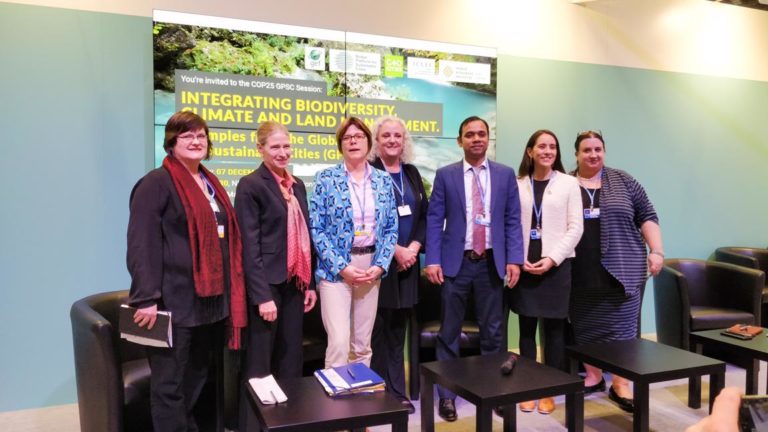There’s an urgent need for cities to do a better job of protecting biodiversity, due to nature’s critical role both in combating climate change and improving quality of life. That was the overarching message at yesterday’s session on Integrating Biodiversity, Climate and Land Management at COP25.
This article, first published on the ICLEI blog, is part of our “COP25” Editorial Series, done in partnership with ICLEI — Local Governments for Sustainability.
“We all know that the reduction of one-third of greenhouse emissions can come from nature,” observed Eva Gurria, the Nature-Based Solutions Lead with the Executive Office of the UN Secretary-General. “But beyond carbon, nature-based solutions are closely tied to (the UN’s) sustainable development goals.”
As part of taking conservation efforts more seriously, speaker Valerie Hickey, manager of the World Bank’s Environmental and Natural Resources practice, said cities need to begin thinking of biodiversity as an asset versus another cost on their balance sheet. “The City of London saw its public parks and green spaces as a liability, until they conducted a natural capital accounting analysis. And what they found is [the parks and green space] provide a value of £5 billion a year.”
[A]nd every £1 spent on green space translated into £27 in value.
The findings of the London study Hickey cited were released by the city in 2017, and included in the overall £5 billion figure was that opportunities for exercise, relaxation, social contact and tranquility had a value of £950 million in avoided health costs each year; and every £1 spent on green space translated into £27 in value.
Quantifying the capital benefits of nature in an urban setting is necessary to make the case for these solutions. “There is a 5 trillion dollar need for infrastructure upgrades around the world, but if we want to make our communities resilient, we need to spend at least 20% more on nature-based solutions,” Hickey observed.
Alok Barwall, Senior Climate Change Specialist with the Global Environment Facility (GEF), spoke about the challenge of breaking out of “sector silos” to take a more strategic approach to managing natural assets.
Related Articles: Female Mayor ‘Warriors’ of the Amazon Inspire COP25 Delegates With Stories of Resilience | Early Days of COP25 Highlight Plight of Most Vulnerable Nations
“Urban growth is putting biodiversity at risk. Currently, forty percent of protected areas are within 50 kilometers of cities and with unchecked urban growth there’s a risk of destroying natural habitats which can store up to 40 billion tons of carbon,” Barwall said, adding that in order to address this challenge before it’s too late, “we need to transform the way cities function.”
As a prime example of cities that are heading in the right direction, Barwell referenced the Global Platform for Sustainable Cities (GPSC), an urban growth initiative comprised of 11 countries and 28 cities funded by the GEF. GPSC members are currently investing heavily into everything from land and spatial interventions designed to protect urban green space, to nature-based solutions tied to urban cooling.

Simone Raskob, the Deputy Mayor of the City of Essen provided a unique, “on the ground” perspective for the session, profiling her city’s 150-year “grey to green” movement, which has dramatically transformed this former coal mining city into a poster child for embracing biodiversity. “The reason Essen won the European Green Capital Award (in 2017), is we’re a role model for cities undergoing structural change.”
The structural change she discussed was the city’s difficult transition from a coal mining community to one that has invested heavily into restoring nature. Due to a massive clean up of the local waterways as well as a strong emphasis on green space tied to the long term goal of ensuring every resident lives with 500 meters of a park, Essen now has “over 800 different plant and animal species or more than double what we used to have [during the city’s coal mining era]. And we see our efforts not only as green and blue projects, but as projects that can help to reduce unemployment in the region.”
As a way to engage more cities to embark on the path of eco-restoration, Kobie Brand, the Global Director of the ICLEI Cities Biodiversity Center encouraged members of the audience to join CitiesWithNature initiative. CitiesWithNature is a knowledge-sharing platform designed to protect biodiversity in order to prevent irreparable loss. Currently, 107 cities from 44 countries belong to the initiative.
[W]hat I want to emphasize is that more and more evidence is coming out from scientists, that nature contributes to physical, spiritual, mental and community well-being.
— Kobie Brand, Global Director of the ICLEI Cities Biodiversity Center
She said the common thread with participating cities is “they know that we need to restore our ecosystems.” As part of her closing comments, she observed that beyond the value of nature for climate adaptation, “what I want to emphasize is that more and more evidence is coming out from scientists, that nature contributes to physical, spiritual, mental and community well-being.”










